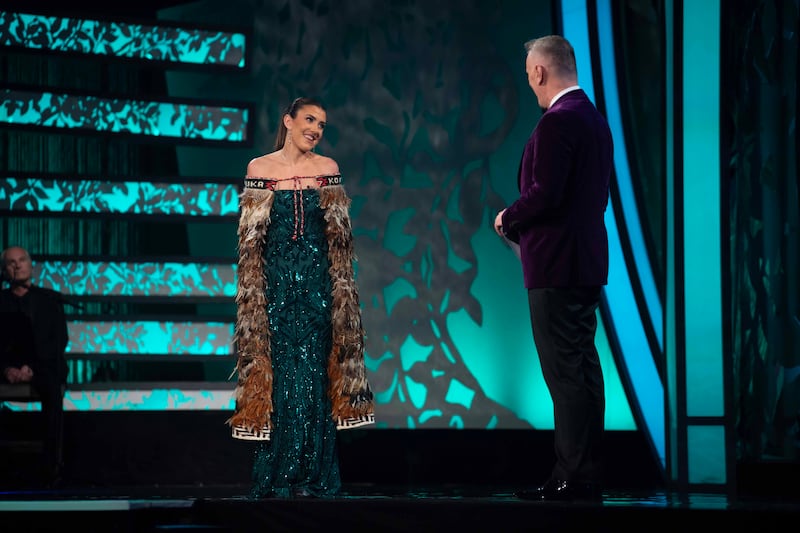A small group of journalists and Rose of Tralee fans stand at the monument to the Rose of Tralee in Tralee’s Rose Garden, waiting for Keely O’Grady, this year’s Rose of Tralee. There’s a statue of the original subject of the song, servant Mary O’Connor, with her aristocratic true love, William Pembroke Mulchinock, and it’s surrounded by a circle glass panels in which are engraved all of the Roses since 1959. New panels go up every four years.
The new winner, New Zealand Rose Keely O’Grady arrives sheltering from the rain under a chaperone’s umbrella, wearing the sash she inherited last night from last year’s Rose of Tralee, Róisín Wiley, as well as some incongruous sunglasses perched on her head. “I would ‘woohoo’,” says O’Grady. “But I don’t have a voice, so it’s going to just be a silent…”
She is whisked over to the sensory garden created twenty-five years ago by Joe Carey to have photos taken with fans, including a little girl called Shona who gets her autograph for a second time (this time with the imprimatur of the Rose judges) as well as with Joe and his “dream team” of helpers.
“Take the sunglasses off her there,” says one Rose staffer to another as we bask in gentle drizzle.
READ MORE
“Not near the ponytail,” jokes O’Grady to Joe Carey when he raises his garden shears for the photo.
She also gets a photo taken with John Greehy, a Rose of Tralee fan I met earlier in the week. He’s here with his mother. Each year he gets a photo with the winning Rose and has a t-shirt made with the picture on it. He has five now in total.
O’Grady is still under the rule of the Rose chaperones, the no-nonsense timekeepers and journalist deflectors who are basically the paramilitary wing of the Rose of Tralee festival. “I had a chaperone tapping me on the shoulder at about 3.30 saying he had bad news for me and that it was bedtime,” she says and laughs. “They’re still on my case. They’re tough to crack.”
O’Grady’s Irish roots are through her dad Shane who came to New Zealand from Sutton in Dublin in 1999. She is a New Zealand Irish dance champion and has been to Ireland competing in the past. “In Ireland you’re surrounded by Irishness so you don’t have to try and reach out for your Irish connection whereas in New Zealand to connect with my Irishness, I have to go to my dance class, I have to head out to my local Irish society… When you’re in Ireland you might take that for granted.”

On stage on Monday night, before doing a performance of Gypsy from Riverdance, O’Grady wore a traditional woven Māori korowai lent to her by Sir Tipene O’Regan an activist of Irish and Māori heritage. “I wanted to make sure I was representing New Zealand culture and New Zealand people as a whole, and a really big part of that to me is our indigenous people and our indigenous culture… I wanted to bring a little piece of that on stage with me.”
The previous night, just before being whisked into a stage on Denny Street to be received by the people of Tralee, she said that New Zealand and Ireland “have really similar experiences with colonisation, and that the cultural revitalisation effects that they’re putting in place today, in terms of revitalising the indigenous languages…. traditions and arts, that is something that is reflected very similarly in both countries.” She wished to show, she says, “the strength that Irishness has, the fact that it can be so well represented when intertwined with other cultures like [the] Māori in New Zealand.”
O’Grady’s immediate plans involve finishing her degree in speech and language therapy but she’s considering a move to Ireland after that. On Tuesday night she told journalists how she describes the Rose to people back home. “It’s a beauty pageant that’s not about beauty. It’s about ambitions. It’s about aspirations. It’s about self-worth and talent. And it’s about the strength of women and it’s about celebrating a shared culture and connection and heritage that we all have, all the girls that enter the competition. That’s how I like to try and explain it.”
- Sign up for push alerts and have the best news, analysis and comment delivered directly to your phone
- Join The Irish Times on WhatsApp and stay up to date
- Listen to our Inside Politics podcast for the best political chat and analysis














